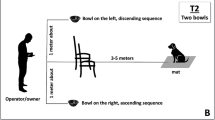Abstract
TwoCebus albifrons monkeys were trained to press a back-lighted panel to postpone a brief electric shock to the tail using a Sidman avoidance schedule (SS = 40 sec, RS = 40 sec). After 25 training sessions, a discriminative schedule was introduced, with the Sidman avoidance continuing in the presence of one discriminative stimulus and punishment introduced in the presence of the other. The discriminative stimuli were colors on the panel. Discriminative training also involved 25 sessions, each with a random sequence of 6 avoidance and 6 punishment segments, with 30 sec intervals between the segments. Plantar skin conductance and heart rate were recorded along with the panel-pressing behavior. The two monkeys adjusted to the discriminative schedule quite differently from one another. One animal responded at a high level and avoided very well (during avoidance) but was punished frequently (during punishment). The other animal responded less frequently and received many shocks during avoidance but almost none during punishment. The animal that showed less ability to inhibit responding (and received about four times as many shocks overall) appeared to have discriminated better temporally in spacing its responses during avoidance training. The monkey whose panel-pressing behavior resulted in more shocks also tended to show a higher tonic level of autonomic arousal. However, within-animal differences in shock frequency (between avoidance and punishment) were not similarly related to autonomie arousal. The animal that received fewer shocks overall (but more during avoidance) showed greater arousal during punishment. The animal that received more shocks overall (but fewer during avoidance) showed no arousal differences between avoidance and punishment.
Similar content being viewed by others
References
Anger, D.: The dependence of interresponse times upon the relative reinforcement of different interresponse times. J. Exper. Psychol.52, 145–161, 1956.
Brady, J. V., Findley, J. D. and Harris, A.: Psychophysiology of emotion.In Kimmel, H. D. (ed.);Experimental Psychopathology. New York, Appleton-Century-Crofts, 1971.
Kimmel, H. D., Brennan, A. F., McLeod, D.,et al.: Instrumental electrodermal conditioning in the monkey (Cebus albifrons): Acquisition and long-term retention. Anim. Learning Behav. in press.
Mackintosh, N. J.:The Psychology of Animal Learning. New York, Academic Press, 1974.
Sidman, M.: Avoidance behavior.In Honig, W. K. (ed.):Operant Behavior: Areas of Research and Application. New York, Appleton-Century-Crofts, 1966.
Venables, P. H. and Christie, M. J.: Mechanisms, instrumentation, recording techniques, and quantification of responses.In Prokasy, W. F., and Christie, D. C. (eds.):Electrodermal Activity in Psychological Research. New York, Academic Press, 1973.
Author information
Authors and Affiliations
Additional information
Supported by a grant from the United States Army Medical Research and Development Command to H. D. Kimmel (DAMD 17-76-0-6053), and based upon M. S. Raich’s master’s thesis, the Department of Psychology, University of South Florida.
Rights and permissions
About this article
Cite this article
Raich, M.S., Kimmel, H.D. Autonomic concomitants of discriminative avoidance and punishment training in the monkey. Pav. J. Biol. Sci. 14, 243–248 (1979). https://doi.org/10.1007/BF03003006
Issue Date:
DOI: https://doi.org/10.1007/BF03003006




